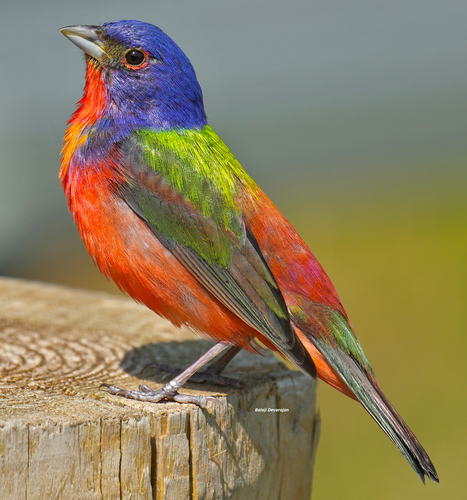
Painted Bunting
The Painted Bunting (Passerina ciris) is a small, strikingly colorful songbird renowned for the male's vibrant plumage. Often described as one of North America's most beautiful birds, it plays a vital ecological role as a seed disperser and insect consumer. While not holding major cultural significance in the same way as some iconic birds, its beauty has made it a favorite among birdwatchers and a symbol of biodiversity in its range. It faces several conservation challenges, making understanding its biology and ecology crucial.
12-14 cm
Length
21-23 cm
Wingspan
Near Threatened
Conservation Status
Distribution
The Painted Bunting has two distinct breeding populations. One is in the south-central United States (parts of Texas, Oklahoma, Arkansas, Louisiana) and northern Mexico. The other is along the Atlantic coast of the southeastern United States (parts of Florida, Georgia, South Carolina, and North Carolina). They migrate south to winter in southern Florida, Cuba, the Bahamas, Mexico, and Central America, as far south as Panama.
Lifespan
Up to 10 years in the wild, although most live significantly shorter lives. Captive birds may live longer.
Painted Bunting's Habitat
Habitat Types
Shrublands, Woodland edges, Thickets, Riparian areas
Climate Zones
Temperate, Subtropical
Adaptations
Their relatively small size and preference for dense vegetation provide cover from predators. Their strong beaks are adapted for cracking seeds, a staple of their diet, especially during migration and winter.
Variations
Two subspecies are generally recognized: *Passerina ciris ciris* (eastern population) and *Passerina ciris pallidior* (western population). The western males tend to be slightly paler in coloration.
Appearance
Breeding Plumage
Males in breeding plumage are unmistakable: bright blue head, green back, red rump and underparts. Females and immature males are a dull green overall. Non-breeding males resemble females, though they may show hints of blue and red.
Seasonal Feather Changes
Males molt into their bright breeding plumage in the spring before migration. After breeding, they molt back into a more subdued plumage.
Sex Based Plumage Differences
Extreme. Males are brightly colored, while females are a plain green, providing camouflage while nesting.
Notable Features
Brightly multi-colored plumage in males (blue, green, red), Strong, conical beak for seed-eating, Rounded wings
Diet and Feeding
Primary Foods
Seeds, Insects, Spiders
Foraging Behavior
Painted Buntings forage on or near the ground, often hopping through dense vegetation. They glean insects from leaves and stems and pick seeds from the ground or low-lying plants.
Specializations
Their strong, conical beak is a specialization for cracking seeds, a crucial food source, particularly during migration and the non-breeding season.
Seasonal Diet Variations
During the breeding season, their diet shifts to include more insects, providing protein for growing chicks. In the winter, they rely more heavily on seeds.
Behavior
Social Structure
Generally solitary or in pairs during the breeding season. They may form small flocks during migration and in wintering areas.
Communication
A soft, sweet warbling song by the male, Sharp 'chip' calls for alarm or contact
Migration
Painted Buntings are migratory, traveling south to wintering grounds in Mexico, Central America, and the Caribbean. They migrate at night, navigating by the stars.
Territorial or Group Behaviors
Males are highly territorial during the breeding season, defending their nesting area from other males. They are less territorial on their wintering grounds.
Conservation
Threats
Habitat loss and fragmentation, Nest parasitism by Brown-headed Cowbirds, Illegal trapping for the cage-bird trade (particularly in Mexico and the Caribbean), Collisions with buildings
Protection Programs
Habitat restoration and management efforts, Monitoring of populations, Public awareness campaigns
Local National Laws
Protected under the U.S. Migratory Bird Treaty Act, making it illegal to harm or possess them without a permit.
Population Trend
Decreasing
Population Estimates
While precise numbers are difficult to obtain, the global population is estimated to be declining.
Interesting Facts
The name "cirs" comes from the Greek word for a type of seabird.
The connection to a seabird is unclear, as the Painted Bunting is a terrestrial species. It may be a case of mistaken identity or a reference to some aspect of the bird's behavior that is no longer understood.
Male Painted Buntings can sometimes be polygynous.
meaning they may have more than one mate in a single breeding season.
The two distinct breeding populations (eastern and western) rarely interbreed.
This geographic isolation has led to some genetic and plumage differences between the two groups.
Faqs about Painted Bunting
What can I do to help Painted Buntings?
Support habitat conservation efforts, avoid using pesticides in your yard, and keep cats indoors to reduce predation. You can also plant native vegetation to provide food and shelter.
Where is the best place to see a Painted Bunting?
Look for them in shrubby areas and woodland edges within their breeding range during the spring and summer. They can also be seen during migration at stopover sites.
Do Painted Buntings come to bird feeders?
They may visit feeders offering white millet or sunflower seeds, especially during migration. However, they prefer natural food sources.
Copyright @ Nature Style Limited. All Rights Reserved.
 English
English